 Most viewed - Mt. Oyama 大山 Most viewed - Mt. Oyama 大山 |
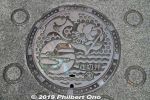
Manhole in Oyama, Isehara, Kanagawa Prefecture.60 views
|
|
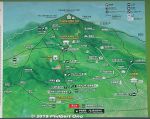
Mt. Oyama has roads, hiking paths, and a cable car going up the mountain. The main road (accessible by bus) goes up through a valley on the mountain until it reaches near the cable car station.36 viewsMost people only go halfway (elevation 700 meters) up the mountain to Oyama Afuri Shrine's Shimosha (Lower Shrine). People wanting a more challenging trek can hike to the summit to visit the Honsha main shrine. Mt. Oyama is 1,252-meters high (4,108 ft) and part of the Tanzawa Mountains.
|
|
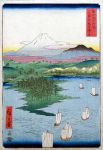
Mt. Oyama appears in quite a few ukiyoe prints usually along with nearby Mt. Fuji. This one is by Hiroshige in 1858 as seen from Yokohama. Image courtesy of 神奈川県郷土資料アーカイブ.29 views
|
|

Entrance to Negishi Ryokan, one of many pilgrims' inns called "shukubo" where pilgrims would stay. During the Edo Period, Oyama had hundreds of pilgrims' inns, but now only about 40+ remain. 根岸旅館27 viewsShukubo lodging rates start from ¥10,000 per person per night including dinner and breakfast. To search for a shukubo on Oyama, see http://ooyama-ryokan.com/english/index.html
|
|
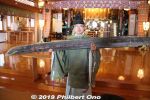
Oyama Afuri Shrine priest Kunihiko Meguro showed us a large wooden sword that was offered to the shrine by a pilgrimage group in 1905. (大山阿夫利神社).26 viewsThe tradition of bringing and offering a sword by pilgrimage groups started with Kamakura-based Shogun Minamoto no Yoritomo (1147–1199) who offered a sword to the shrine to pray for the defeat of his enemy, the Taira Clan. The offered swords got as big as 6 meters long made of wood.
|
|
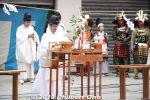
Food offerings for the arriving deity.26 views
|
|

Mt. Oyama in Isehara, Kanagawa is about halfway to Hakone near Mt. Fuji. Easy day trip from Tokyo. During the Edo Period (1603–1867), Mt. Oyama was very popular for pilgrimages by the fun-loving masses in Edo/Tokyo.25 viewsIt had many shrines and temples and mountain ascetic priests. When Edo/Tokyo's pop. was 1 million, Oyama saw 200,000 pilgrims per year. Today, there are fewer shrines and temples and pilgrims, but it's still a pleasant place to visit and less crowded than more well-known spots. The main attractions are Oyama Afuri Shrine and Oyama-dera Temple.
From Shinjuku, take the Odakyu Line to Isehara Station (about 1 hour). Get out the North Exit, and go to bus stop 4 to take the bus to the Oyama Cable stop. Google Map to Mt. Oyama
|
|
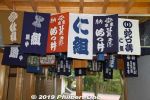
Nuno-maneki banners.25 views
|
|
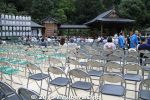
Cheap seats were ¥1,500.25 views
|
|
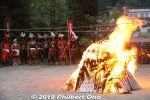
Bon fire burned until it got dark. The sacred fire was also used to light the torches near the Noh stage.25 views
|
|
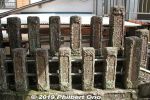
Pilgrimage groups formed among neighborhoods and occupations and they sent delegations to Oyama every year to pray on the group's behalf. It took 2 to 3 days to walk from Edo/Tokyo.24 viewsMt. Oyama became a destination for fun besides religion. Along the Koma-sando, you can see these many stone monuments and plaques engraved with the names of pilgrims and pilgrimage groups who worshipped on Oyama. Lots of names everywhere on this mountain.
|
|
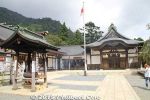
24 views
|
|

About Roben Falls where ascetic Buddhist Priest Roben first bathed and founded Oyama-dera Temple in 755. Roben also had a hand in founding the famous Todaiji Temple in Nara that houses the giant Buddha and Ishiyama-dera Temple in Otsu, Shiga..24 views
|
|
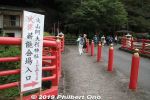
Way to the Takigi Noh venue.24 views
|
|
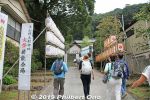
Way to Oyama Afuri Shrine's Noh stage at the Shamukyoku shrine office. 社務局24 views
|
|
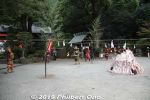
Entrance of the sacred fire that was created in the Haiden in the early morning.24 views
|
|
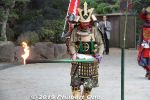
Before it got dark, some people dressed as samurai arrived near the Noh stage with sacred fire torches.24 views
|
|
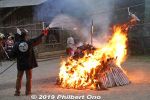
24 views
|
|
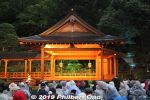
Torches near the Noh stage were also lit. Noh started on Mt. Oyama 300 years ago when the shogun ordered the conflicting religious groups on the mountain to work together to stage a Noh play twice a year. 24 viewsThis was to prevent fighting from breaking out on the mountain. Priests in those days were armed and warrior-like. The strategy worked as Oyama's Shintoists, Buddhists, and ascetic priests made peace and worked together to perform Noh in the Kanze School.
|
|
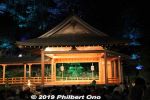
The Noh tradition on Oyama was disrupted due to the Great Kanto Earthquake in 1923 and World War II, but it was resurrected in the 1980s.24 viewsThe background trees were also beautifully illuminated. Also notice the small torches. Starting at 4 pm, four plays including a dance and kyogen were performed. Ended at 7:30 pm. They also had a beautiful bilingual (Japanese and English) program explaining much about the Oyama, Afuri Shrine, and Noh.
|
|
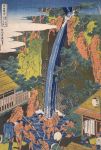
Ukiyoe print of Roben Falls used by Oyama pilgrims to purify themselves. Notice the long wooden swords.24 views
|
|

More names of pilgrims.23 views
|
|
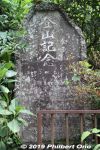
Pilgrimage monument.23 views
|
|
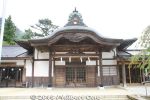
Kyakuden waiting room for worshippers. 客殿23 views
|
|

Entrance to the hiking path to the Honsha main shrine on Mt. Oyama's summit. Takes about 2 hours to reach the summit. Steep and rocky trail. 登拝門23 views
|
|
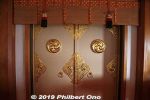
23 views
|
|
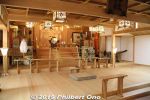
23 views
|
|
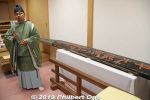
Oyama Afuri Shrine priest Kunihiko Meguro showed us a large wooden sword that was offered by a pilgrimage group.23 views
|
|
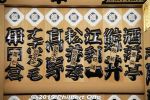
Names of worshippers who had tattoos. Their names also have labels describing their tattoos for ID purposes.23 views
|
|
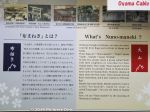
About Nuno-maneki banners.23 views
|
|

Oyama Cable car tracks going down.23 views
|
|

Oyama Cable Station.23 views
|
|
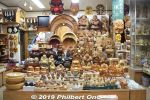
We walked back down the Koma-sando steps.23 views
|
|
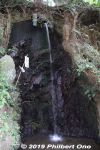
Roben Falls. During the Edo Period, pilgrims would bathe under these falls for purification. Roben Falls was made famous by woodblock prints showing tattooed pilgrims bathing here. 良弁滝23 views
|
|

Local Oyama beer. The local sake is also good because of the good water.23 views
|
|
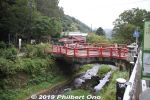
Bridge over Oyama River.23 views
|
|
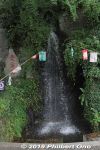
Atago Falls 愛宕滝23 views
|
|
|
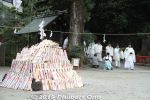
Wooden prayer tablets for a bon fire.23 views
|
|
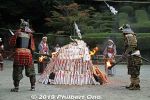
They lit the bon fire made of prayer tablets. This was the fire festival (火祭) part of the event.23 views
|
|
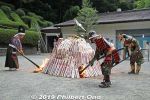
23 views
|
|
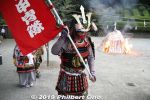
23 views
|
|
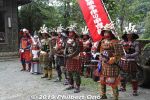
23 views
|
|
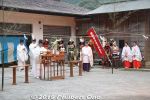
23 views
|
|
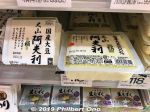
Afuri tofu in a supermarket in Tokyo.23 views
|
|
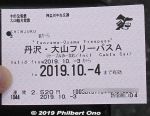
From Tokyo, take the Odakyu Line from Shinjuku Station to Isehara Station (about 60 min.). No need to take the Romance Car express train. The "Tanzawa-Oyama Free Pass A" is a good deal for a roundtrip, including bus and the cable car on Mt. Oyam23 viewsValid for 2 days and costs ¥2,520. If you prefer not to take the cable car and hike instead, buy "Tanzawa-Oyama Free Pass B" which is cheaper at ¥1,560. You can buy the pass at any Odakyu Line train station like Shinjuku, Machida, Yamato, and Isehara Stations. Use the ticket vending machine.
|
|
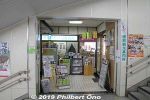
When going down the stairs at Isehara Station's North Exit, you can drop by this tourist information office to pick up brochures.23 views
|
|

One easy way to explore Mt. Oyama: 1. From Isehara Station Kitaguchi (North Exit), go to bus stop 4 and take a bus for Oyama Cable (30 min). 22 views2. From the bus stop, walk up the Koma-sando path to Oyama Cable Station (20 min.).
3. Take the Oyama Cable car to Afuri Jinja Station. (6 min.).
4. Visit Oyama Afuri Shrine Shimosha.
5. Take the Oyama Cable car back down. If you want, get off at Oyama-dera Station to visit Oyama-dera Temple.
6. From Oyama Cable Station, walk back down the Koma-sando path to Oyama Cable bus stop for the bus back to Isehara Station.
|
|
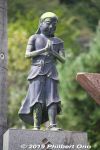
Statue from Oyama-dera Temple greeting worshippers.22 views
|
|
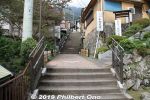
This path is not wheelchair accessible.22 views
|
|
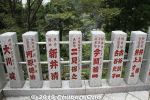
Stone markers engraved with names of shrine donors and their locale.22 views
|
|

In the old days, it was a tradition for pilgrimage groups to worship at Oyama and offer a large wooden sword as depicted by this statue. The offertory swords were small at first, then they got as big as 6 meters long. 22 viewsPilgrimage groups (called -ko 講) from the same area or occupation still come to worship at Mt. Oyama.
|
|
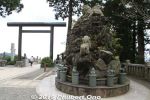
Torii at the top of the steps and Oyama mountain of lions.22 views
|
|
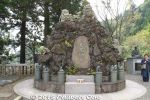
Oyama mountain of lions surrounded by animals from the Oriental zodiac. This is actually a large rock brought here from Mt. Fuji. Mt. Oyama's deity is the father of Mt. Fuji's goddess. 獅子山22 views
|
|
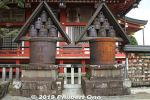
Huge monument that everyone stares at and wonder what it is. This sculpture of steel water buckets seems to be related to fire prevention, donated by people from Kawagoe, Saitama. 武蔵 川越22 views
|
|
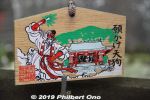
Ema tablet with a tengu goblin and Haiden Hall.22 views
|
|
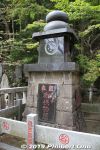
Monument from a pilgrimage group from Yanaka.22 views
|
|
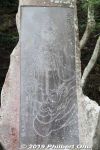
O-tengu goblin monument. 大天狗22 views
|
|

Steps to the Honsha main shrine on the mountaintop. From here, it's about a 90-min. hike to the Honsha main shrine on the summit.22 views
|
|
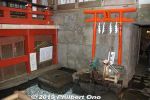
In the shrine's Haiden basement passage, Oyama meisui sacred water from a natural spring in the shrine's basement. You can fill your water bottle with this drinkable water. 大山名水22 views
|
|
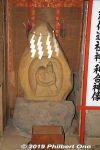
ぼけ封じ守護神22 views
|
|
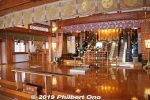
Oyama Afuri Shrine altar (大山阿夫利神社).22 views
|
|
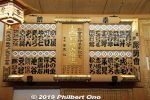
22 views
|
|
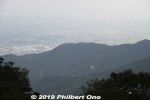
22 views
|
|
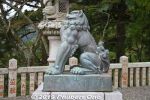
Lion statue at the shrine entrance.22 views
|
|
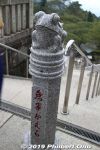
Frog for a safe return. "Kaeru"22 views
|
|
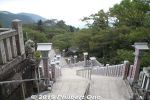
Steps back down. Mt. Oyama has Oyama-dera and a few other notable spots, but we didn't have time to visit them this day.22 views
|
|

Oyama Cable car going down.22 views
|
|

Motodaki Falls where worshippers would purify themselves before going to worship. 元滝22 views
|
|
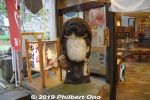
Tanuki22 views
|
|
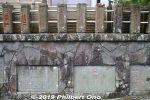
Names of pilgrimage groups and individuals along the roadside.22 views
|
|

Plaque on "Tofu Road" where there were many tofu maker/sellers. Afuri tofu is famous because of Oyama's good water. Local inns started making tofu with the local water and the soybeans pilgrims brought as payment for lodging.22 views
|
|
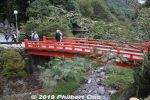
22 views
|
|
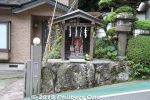
Roadside shrine for Fudo Myo-o.22 views
|
|
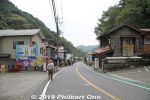
Walking down the main road.22 views
|
|
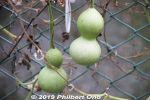
Baby gourds.22 views
|
|

Oyama Himatsuri Takigi Noh is held annually on two successive days in early Oct. It's an outdoor Noh play under firelight. This Noh tradition goes back 300 years. Saw it on Oct. 3, 2019. PR poster for Takigi Noh on Mt. Oyama.22 views
|
|
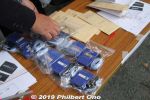
Audio guide for English interpreting.22 views
|
|
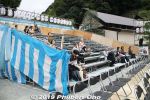
Bleachers.22 views
|
|
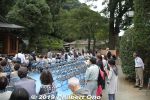
22 views
|
|
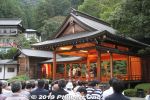
Before the Noh play, these local kids went on stage and explained about the Noh play in English.22 views
|
|
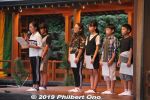
I was very impressed by their English. Very good explanation and excellent English coaching. Wish all festivals in Japan did this.22 views
|
|
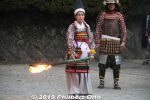
22 views
|
|
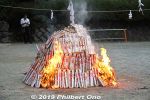
The fire is to invite the shrine's deity to this festival site.22 views
|
|
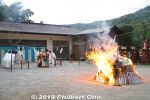
22 views
|
|

Ukiyoe print of pilgrims climbing Mt. Oyama. By Utagawa Yoshifuji in the 19th century. 歌川芳藤22 viewsDuring the Edo Period, Mt. Oyama was one of the first sacred sites that allowed pilgrimages by commoners. In the old days, making the trip to Oyama by oneself was too difficult, so they formed pilgrimage groups.
|
|
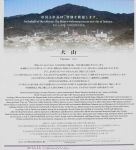
Pyramid-shaped Mt. Oyama is also called "Amefuri-yama" or mountain of abundant rain since it was often shrouded in clouds. Farmers prayed to the mountain for rain. 21 viewsThe mountain's deity, Oyama-tsumi-no-Kami, is the father of the goddess of nearby Mt. Fuji. It is also a Japan Heritage site. A great time to visit would be in mid-November for the autumn leaves.
|
|
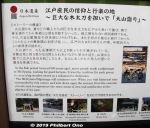
Mt. Oyama once had so many pilgrims that several roads from Tokyo (Edo) and surrounding areas leading to Oyama were dubbed "Oyama-do Road" (大山道).21 viewsThe road named Aoyama-dori Oyama Road started from Akasaka and passed through Sangenjaya (Three Teahouses). Sangenjaya originally had only two teahouses serving pilgrims going to Oyama. A third teahouse was added to serve the many Oyama pilgrims and that's how Sangenjaya got its name.
|
|
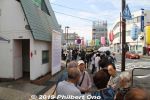
From Isehara Station's North Exit, there was this long line for the bus stop 4. Some people were going on a different bus, but we all got on the right bus.21 views
|
|
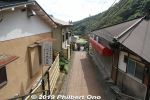
Looking back down the path.21 views
|
|

21 views
|
|
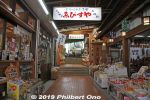
Souvenir shops.21 views
|
|

At the Oyama Cable Station, we took the cable car halfway up the mountain to Afuri Jinja Station. It's 280 meters long up the slope and runs every 20 min. from 9 am to 5 pm on weekends or until 4:30 pm on weekdays. It's also possible to hike up.21 views
|
|

There's only one station in-between where the trains going in opposite directions pass each other. This is Oyama-dera Station if you want to visit Oyama-dera Temple.21 views
|
|
|
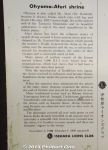
About Afuri Shrine.21 views
|
|
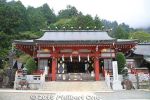
Oyama Afuri Shrine (大山阿夫利神社) Haiden prayer hall. The shrine was built to bring rain for agriculture. One of the gods enshrined is the father of Mt. Fuji's goddess. 21 views拝殿
|
|
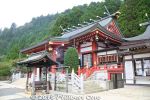
Haiden prayer hall. On the right of the Haiden, you can see the entrance to the basement where there is natural spring. 拝殿21 views
|
|
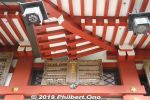
21 views
|
|
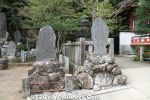
Lots of monuments at Oyama Afuri Shrine.21 views
|
|
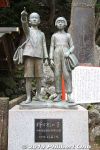
Children's monument from the city of Kawasaki.21 views
|
|
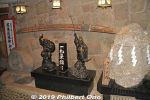
Religious sculptures, monuments, and a wooden sword offering displayed in the shrine's Haiden basement passage. 一礼来福21 views
|
|
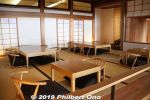
Afuri Shrine's cafe named Sekison, the indoor dining room. Open 9:30 am–4 pm. 石尊21 views
|
|
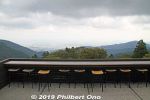
Afuri Shrine's Sekison cafe also has this outdoor counter with a view. On clear days, Enoshima and the ocean can be seen. 石尊21 views
|
|

Passing loop at Oyama-dera Station.21 views
|
|
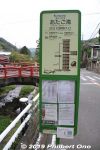
Atagodaki bus stop for the bus bound for Isehara Station.21 views
|
|
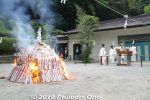
21 views
|
|

For Oyama Afuri Shrine's 39th Fire Festival Takigi Noh on Oct. 3, 2019, a Kyogen play called "Neongyoku" and Noh play called "Momojigari" were performed.21 viewsPerformers were top class from the Kanze School of Noh and the Okura School of Kyogen. Sorry, but photography of the performances wasn't allowed so I don't have photos of the performances. Many thanks to Alice Gordenker who organized the tour and provided English explanations.
|
|
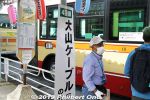
From Isehara Station's North Exit, go to bus stop 4 and take the bus going to Oyama Cable bus stop, taking about 30 min.20 views
|
|
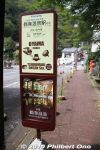
Got off the bus at the Oyama Cable bus stop and walk to the Koma-sando path nearby.20 views
|
|

Sloping path.20 views
|
|
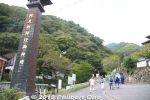
Entrance to the uphill Koma-sando path to Oyama Cable car station. 20 views
|
|
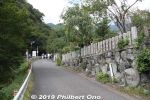
Way to Koma-sando path.20 views
|
|
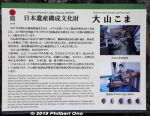
About spinning tops in Oyama. Made locally with lathes and used as amulets or gifts.20 views
|
|

Tops on the Koma-sando path. "Koma" means "top."20 views
|
|

Tops for sale.20 views
|
|

Tanuki at shop entrances is common on Oyama. Afuri tofu cuisine is also recommended.20 views
|
|
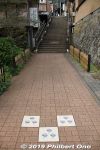
20 views
|
|
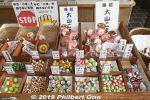
More tops.20 views
|
|

More steps. Just walk up at a leisurely pace.20 views
|
|

14th landing on the path.20 views
|
|
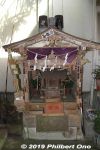
20 views
|
|
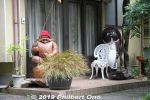
20 views
|
|
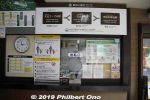
Oyama Cable Station ticket window.20 views
|
|
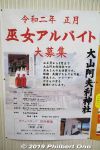
Poster to recruit omiko shrine maidens for New Year's 2020. They won't get paid much. ¥1,020/hour.20 views
|
|
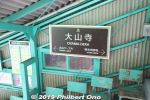
To visit Oyama-dera Buddhist Temple, get of at this station. (During this trip, we didn't visit Oyama-dera Temple, dedicated to Fudo Myo-o.)20 views
|
|

Inside the Oyama Cable car.20 views
|
|
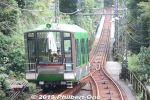
Passing loop at Oyama-dera Station.20 views
|
|
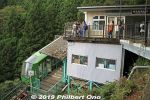
After about 6 min., we reached Afuri Jinja Station, the last stop.20 views
|
|
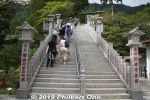
Steps to Afuri Jinja Shrine are lined with stone markers engraved with names of shrine donors.20 views
|
|
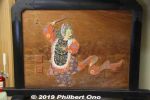
In the shrine's Kyakuden lobby, a screen partition depicting the Ranryo-o court dance. 蘭陵王20 views
|
|
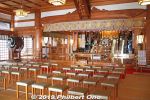
Inside Oyama Afuri Shrine (大山阿夫利神社).20 views
|
|
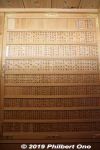
Names of shrine supporters.20 views
|
|

Galette for lunch. (ガレット)20 views
|
|
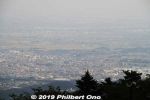
Hazy when we were there, but Enoshima island would be visible on clear days.20 views
|
|
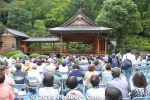
Noh stage at Oyama Afuri Shrine (大山阿夫利神社) for Takigi Noh performance. "Takigi" means "firewood" so the Noh play was held in the evening with burning torches. 火祭薪能20 views
|
|
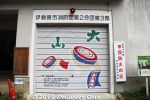
Tops on the local fire station.19 views
|
|
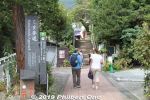
Koma-sando is a path of steps leading to the temple and shrine. It passes by souvenir shops, eateries, and inns and goes to the Oyama Cable Station. It's not too strenuous, taking about 20 min. こま参道19 views
|
|
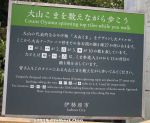
How to count the tops on the Koma-sando path.19 views
|
|
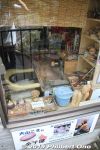
Maker of tops with a lathe.19 views
|
|

Almost at cable car station.19 views
|
|
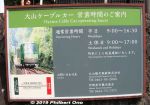
Oyama Cable Car hours.19 views
|
|
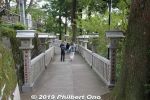
Way to Afuri Shrine. Mt. Oyama once had many temples and shrines allied with local feudal lords. But they were forced to disband by the Tokugawa shogunate during the Edo Period until only two were left: Oyama Afuri Shine and Oyama-dera Temple. 19 views
|
|
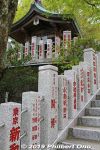
19 views
|
|

The Koma-sando path to Oyama Cable Station is mainly concrete steps lined with souvenir shops, restaurants, and ryokan inns for pilgrims.18 views
|
|
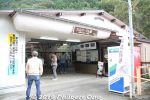
Oyama Cable Station18 views
|
|
|
|
|
|